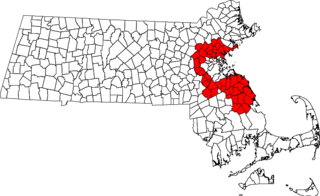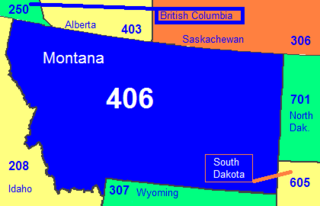Area codes 705, 249, and 683 are telephone area codes in the North American Numbering Plan (NANP) for most of northeastern and central Ontario in Canada. Area code 705 was created in a 1956 area code split from portions of the 613 and 519 numbering plan areas. After a reduction in geographic coverage in 1962, the numbering plan area was assigned a second area code, 249, in 2011 to form an overlay numbering plan. A third area code, 683, was added in June 2022.
Area codes 905, 289, 365, and 742 are telephone area codes in the North American Numbering Plan (NANP) for the Golden Horseshoe region that surrounds Lake Ontario in Southern Ontario, Canada. The numbering plan area (NPA) comprises (clockwise) the Niagara Peninsula, the city of Hamilton, the regional municipalities of Halton, Peel, York, Durham, and parts of Northumberland County, but excludes the City of Toronto.

Area code 701 is a telephone area code in the North American Numbering Plan (NANP) for the U.S. State of North Dakota. It is one of the 86 original North American area codes created by AT&T in 1947, and continues to be the only area code in North Dakota, one of eleven states with only one area code.

Area code 781 and 339 are telephone area codes in the North American Numbering Plan for the U.S. state of Massachusetts. The numbering plan area consists of Boston’s inner suburbs, known as the Route 128 corridor, and some outer suburbs, especially in the South Shore region. It was created as in an area code split of area code 617 on September 1, 1997. Use of 781 became mandatory February 1, 1998. Area code 339 is an overlay complex code for the same service area, activated on May 2, 2001. Since then, ten-digit dialing has been mandatory.

Area code 780 is a telephone area code in the North American Numbering Plan (NANP) for the Canadian province of Alberta. The numbering plan area comprises the northern two thirds of the province, including the Edmonton area. The area code was established in 1999 in a split of area code 403, which had served the entire province since the establishment of the original North American area codes in 1947. The numbering plan area is also served by area codes 587, 825, and 368, which form a complex overlay for all of Alberta.
Area codes 902 and 782 are telephone area codes in the North American Numbering Plan (NANP) for the Canadian provinces of Nova Scotia and Prince Edward Island. Area code 902 was one of the nine original North American area codes in Canada established in October 1947. Area code 782 was added to the numbering plan area in August 2014, to form an overlay complex in relief to prevent telephone number shortages.

Area code 709 is the telephone area code in the North American Numbering Plan (NANP) for the entire Canadian province of Newfoundland and Labrador.

Area code 604 is a telephone area code in the North American Numbering Plan for southwestern British Columbia, Canada. The numbering plan area comprises the Lower Mainland, Sunshine Coast, Howe Sound / Sea to Sky Corridor, Fraser Valley and the lower Fraser Canyon regions. The major city is Vancouver. The area code is one of the nine original North American area codes assigned to Canada in 1947.

Area codes 617 and 857 are telephone area codes in the North American Numbering Plan (NANP) for the U.S. state of Massachusetts, serving the city of Boston and several surrounding communities such as Brookline, Cambridge, Newton and Quincy. Area code 617 is one of the original North American area codes created in October 1947, when it served the eastern two-thirds of Massachusetts, from roughly the western end of Worcester County to Cape Cod and the South Coast.

Area code 605 is the telephone area code in the North American Numbering Plan for the entire U.S. state of South Dakota. The numbering plan area was designated in 1947, when the American Telephone and Telegraph Company (AT&T) devised a comprehensive telephone numbering plan for the United States and Canada.

Area code 406 is the telephone area code in the North American Numbering Plan for the entire U.S. state of Montana. It has been Montana's only area code since the American Telephone and Telegraph Company created a nationwide telephone numbering plan in 1947.
Class R:Medicine is a classification used by the Library of Congress Classification system. This page outlines the subclasses of Class R.

Area codes 418, 581, and 367 are telephone area codes in the North American Numbering Plan (NANP) for the eastern portion of the Canadian province of Quebec. Area code 418 was originally assigned to the numbering plan area, but all three area codes now form an overlay plan for this territory. Cities in the numbering plan area include Quebec City, Saguenay, Lévis, Rimouski, Saint-Georges, Alma, Thetford Mines, Sept-Îles, Baie-Comeau and Rivière-du-Loup. Also served are the Gaspé Peninsula, Côte-Nord, southeastern Mauricie, and the tiny hamlet of Estcourt Station, in the U.S. state of Maine.
Homework in psychotherapy is sometimes assigned to patients as part of their treatment. In this context, homework assignments are introduced to practice skills taught in therapy, encourage patients to apply the skills they learned in therapy to real life situations, and to improve on specific problems encountered in treatment. For example, a patient with deficits in social skills may learn and rehearse proper social skills in one treatment session, then be asked to complete homework assignments before the next session that apply those newly learned skills.








